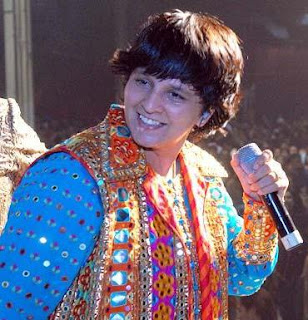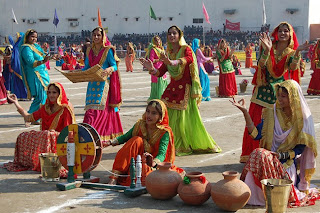Fugdi or "Foogdi" is the most popular folk dance form of Konkan region. It is performed during Hindu religious festivals like Ganesh Chaturthi and Vrata or towards the end of other dances like Dhalo. It is also performed during various religious and social occasions. It is generally performed during the month of Bhaadrapada, an occasion for the women to take a temporary break from their normal, monotonous schedule. In the Konkan region the women fetch water from long distances.
During the dance performance the women sing and dance. This dance is has different variation. In first variation it is performed in circle. In other it is performed in rows. In villages there is a tradition of performing this dance in circle where in the forest region it is performed in rows.
The speciality of this dance is that no songs are sung during this dance performance. They use their hands for clapping. During the dance performance the women move in the circle. During the dance performance the dancer blow air through the mouth at maximum pace. During this process a sound ‘FOO’ can be heard. It is one of the reason for the nomenclature of the dance.
Fugdi songs which are sung during the dance performance are based on ancient stories, family life, complaints, rivalries or people.
This dance form has many variation like Kalashi Fugdi, Bus Fugdi, Kombda, Ghuma, and Pakhwa.
Kalashi Fugdi
Kalashi Fugdi is an interesting folk dance performed by the women of Goa. It is performed before Goddess Lakshmi during the vrata. This dance has been derived from a famous dance called Fugdi. In this dance, a group of women dance with copper pitchers in their hands. While dancing to the music, the women blow into the pitchers. The vessel symbolizes the womb, while blowing into it indicates the act of imparting of life into it.
There is an interesting claim to the origin of this dance. In the villages, it is a norm for the women to fetch water from the nearby river or pond. To break the monotony of the long journey, the women developed this dance by blowing into the empty pitchers.
Goff Dance
It is a folk dance with cords, manifesting joy and happiness of Goan peasants after the harvest. It is performed during the Shigmo Festival in Phalgun (March) month. Each dancer holds a colourful cord hanging at the centre point of the 'Mand' - the place of performance - and starts dancing intricately with the others, forming a beautiful, colourful, intricate braid at the end of the first movement.


















































